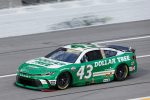The track once known as Atlanta Motor Speedway is now known as EchoPark Speedway. It’s just another item in a massive list of changes and adaptations that have taken place at the Georgia facility.
The track staged its first NASCAR race in 1960 and was then known as Atlanta International Raceway.
Since then, well, trust me, when it comes to such things as amenities, construction, design, financing, legal entanglements, race dates, sponsorships and much more, Atlanta tops ‘em all, in my opinion.
Sure, every track on the NASCAR Cup Series schedule has had its share of challenges and situations that have resulted in adaptations that ensure improvements and sustainability. Over time, it’s all become routine.
But Atlanta, it seems, has metamorphosed so many times over the years that it’s difficult to keep up with it all.
The first race I ever covered at Atlanta was the Atlanta 500 on March 26, 1972. I didn’t have much motorsports journalism experience or knowledge at the time, and I was about to cover my first superspeedway race.
It was also my first road trip for the Roanoke World-News, that city’s afternoon newspaper.
You might imagine how intimidating all of this must have been to a kid sports writer who had never been to a NASCAR big track (the exact location of which he wasn’t certain) in a large metropolitan city.
Fortunately, I got some advice and assistance from the late Gerald Martin of Raleigh, N.C., who had been my predecessor at Martinsville and Roanoke.
He directed me to the Atlanta motel at which most of the veteran motorsports of the day stayed. I was invited to join them for dinner and socializing, which afforded me the welcome opportunity to learn much and enjoy their anecdotes even more.
It was from them that I learned Atlanta had already had a history of a multitude of changes.
The track held its first race after a series of postponements and afterward fell into a long period of multiple ownerships, financial discord, several leadership changes, construction difficulties and more episodes that had consistently threatened its very existence.
It went into bankruptcy in 1971 and the matter was still in the hands of the courts when I walked into its garage area for the first time.
“You might want to walk around and take everything in,” said a veteran writer. “We aren’t sure this place will be around much longer.”
It was in the garage area that I did what I thought was my first piece of enterprising journalism.
Amid the teeming activity of crewmen tending to their cars in various stages of preparation, I noticed one man working on a car located well away from the roofed stations of all the others.
I recognized Wendell Scott of Danville, Va., the only black driver in NASCAR.
He ran his own operation and, as was well known at the time, it operated on a minuscule budget. Scott used what equipment he could acquire through any means possible. It was usually secondhand stuff, which meant he had little chance to win or even finish well enough to pay most of his bills.
And, of course, being black meant that to compete in a white man’s sport, Scott endured more serious social hardships.
I debated whether to approach him. He looked so forlorn as he slowly worked alone on his car so far from the others.
But I spoke to him. I told him who I was and asked him how everything was going and what he hoped to achieve at Atlanta.
He shook my outstretched hand and said things were going about as expected. He hoped he had enough to qualify for the race (he didn’t) and that he had enough useful tires to finish.
“I really need to finish well,” he added. “Don’t know how much longer I can do this. If I don’t earn enough money, I’ll have to think about retirement. About time, to tell you the truth.”
I thought I was onto something. I filed a report that Scott, who had won a Grand National race in Jacksonville, Fla. in 1963, was contemplating retirement.
Soon afterward, I learned that the veterans had been reporting rumors of Scott’s retirement for months.
Scott continued his career into 1973, but it all effectively ended in his second entry of the year at Talladega Superspeedway. He suffered extensive injuries in a massive, multicar crash and entered only one more race before retiring.
When the 1972 Atlanta 500 ended, I was prepared to do my routine reporting of the race, won by Bobby Allison over AJ Foyt and Bobby Isaac.
But something was different; Victory Lane was swamped. Many more jubilant people than I had seen anywhere were there.
The celebration in the grandstands was much louder and lasted much longer than any other I had noticed.
The VIP lounge to the right of the press box was stuffed full of exuberant, happy people. Normally, suites were vacated in short order.
Additionally, a couple of women had used their lipstick to write “Chevy’s Back!” on the suite windows.
Frankly, I didn’t know Chevy had gone anywhere.
Befuddled, I asked the late Bob Myers of the Charlotte News – perhaps the most knowledgeable journalist of the day – what the heck was going on.
He took out his cigar, looked at me for a moment and said, “Don’t you have any idea of what is happening?”
Myers explained to me that Chevy had just won its first NASCAR race in years. It had been absent until 1971, when team owners Richard Howard and Junior Johnson resurrected it for selected events.
They were out to win a championship for Chevrolet, then America’s most popular car, in 1972.
Obviously, the Atlanta victory was a great step toward that goal. Hey, no wonder the numerous Chevy faithful were happy.
I was very grateful to Myers. Had I not inquired, my Atlanta race report would not have reflected the real issue of the day nor the importance of Allison’s victory.
That Atlanta race became my first foray into a season that saw Allison and Chevrolet go to war with Richard Petty and Plymouth.
Their metal crunching clashes on the short tracks have become part of NASCAR lore. What has been far less known – but equally important – was their competition on the big tracks.
Allison won six superspeedway events; he swept Atlanta that year, and Petty only one. But Petty’s edge in short track wins and overall consistency gave him the title.
Atlanta’s financial stability was assured when Bruton Smith’s Speedway Motorsports Inc. purchased it in 1990.
But change was far from over. The spectacular speedway we see today is the result of years of adaptations and transformations, and we can throw many race dates, track modifications, and a name change into the mix.
All of that aside, for me personally, when I think back on my first journalistic adventure and challenge in NASCAR, I always think of Atlanta Motor, uh, that is, EchoPark Speedway.
Steve Waid has been in journalism since 1972, when he began his newspaper career at the Martinsville (Va.) Bulletin. He has spent over 40 years in motorsports journalism, first with the Roanoke Times-World News and later as publisher and vice president for NASCAR Scene and NASCAR Illustrated.
Steve has won numerous state sports writing awards and several more from the National Motorsports Press Association for his motorsports coverage, feature and column writing. For several years, Steve was a regular on “NASCAR This Morning” on FOX Sports Net and he is the co-author, with Tom Higgins, of the biography “Junior Johnson: Brave In Life.”
In January 2014, Steve was inducted into the NMPA Hall of Fame. And in 2019 he was presented the Squier-Hall Award by the NASCAR Hall of Fame for lifetime excellence in motorsports journalism. In addition to writing for Frontstretch, Steve is also the co-host of The Scene Vault Podcast.





